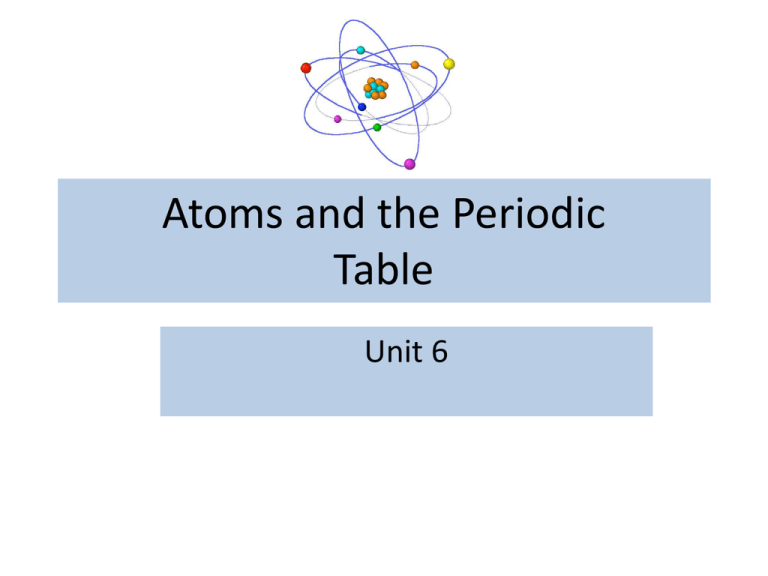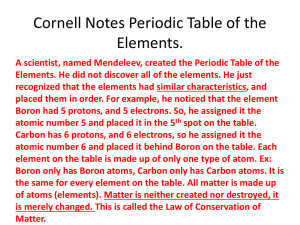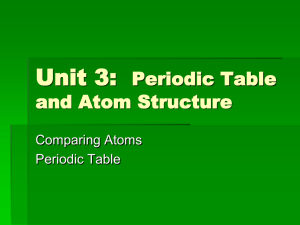Atoms and the Periodic Table
advertisement

Atoms and the Periodic Table Unit 6 Standards • SPS1. Students will investigate our current understanding of the atom. • SPS1a. Examine the structure of the atom in terms of proton, electron, and neutron locations. atomic mass and atomic number, atoms with different numbers of neutrons (isotopes), and explain the relationship of the proton number to the elementʼs identity. Standards • SPS4. Students will investigate the arrangement of the Periodic Table. • SPS4a. Determine the trends of the following: number of valence electrons; Types of ions formed by representative elements; location of metals, nonmetals, and metalloids; Phases at room temperature. • SPS4b. Use the Periodic Table to predict the above properties for representative elements Democritus (400 B.C.) • Proposed that matter was composed of tiny indivisible particles • Not based on experimental data • Greek: atomos John Dalton (1807) • British schoolteacher; based his atomic theory on others’ experimental data • Billiard Ball Model (atom is a uniform, solid sphere) John Dalton Dalton’s Four Postulates 1. Elements are composed of small indivisible particles called atoms. 2. Atoms of the same element are identical. Atoms of different elements are different. 3. Atoms of different elements combine together in simple proportions to create a compound. 4. In a chemical reaction, atoms are rearranged, but not changed. John Dalton • Law of definite proportions: a chemical compound always contains the same elements in exactly the same proportions • (while his theory had flaws,) Dalton’s theories are the foundation for modern atomic theory Henri Becquerel (1896) • Discovered radioactivity (spontaneous emission of radiation from the nucleus) • Three types: – alpha () - positive – beta () - negative – gamma () - neutral J. J. Thomson (1903) • Discovered electrons (negative particles within the atom) • Plum-Pudding Model of atomic structure Ernest Rutherford (1911) • Discovered the nucleus – dense, positive charge in the center of the atom • Nuclear Model Niels Bohr (1913) • Energy Levels – electrons can only exist in specific energy states • Planetary Model -electrons move in circular orbits Erwin Schrödinger (1926) • Quantum mechanics – electrons can only exist in specified energy states • Electron Cloud Model – orbital: region around the nucleus where e- are likely to be found Erwin Schrödinger (1926) Electron Cloud Model (orbital) • dots represent probability of finding an enot actual electron James Chadwick (1932) • Discovered neutrons – neutral particles in the nucleus of an atom The Structure of Atoms • protons: + charge • neutron: no charge • electrons: - charge -very small in mass -electric force holds holds atom together James Chadwick (1932) Neutron Model • revision of Rutherford’s Nuclear Model Atomic Structure 3 main subatomic particles: • Proton: +1; in the nucleus • Neutron: 0; in the nucleus • Electron: -1; cloud around nucleus Atomic Structure • Each element has a unique # of protons • Unreacted atoms have no overall charge (# +protons = # -electrons) • Electric force (opposite charges) holds atom together Elements • Atomic Number = # protons (never, ever changes!) • Mass Number = # protons + # neutrons • Mass number – atomic number = # neutrons Isotopes • Isotopes: vary in mass because the number of neutrons is different • Radioisotopes: emit radiation and decay over time Atomic Mass • Atomic mass unit (u): expresses tiny atomic mass ex. 1 u = 1/12 the mass of a 12C atom • 1 proton = 1 u; neutron = 1 u • Average atomic mass = weighted average (mass # )(# of atoms) (mass # )(# of atoms) total # of atoms Mole • Mole (mol): SI counting unit for small particles • (1 mol = 602,213,670,000,000,000,000,000 • 6.022 x 10³²- Avogadro’s number) Modern Atomic Theory • Modern models: electrons are in certain energy levels (cannot be predicted- Bohr) -orbital: region where electron is likely to be found • Electron energy levels: number of energy levels depend on number of electrons • Electron transitions: Electrons jump between levels when atom gains or loses electrons Electron Energy Levels Valence electrons: • outer level e• Determine chemical properties of atom 3 4 Types of Orbitals Energy Level #/ Type of Orbitals s p Total # Orbitals # Electrons d f 1 1 1=1 2 1 3 1+3=4 8 3 1 3 5 1+3+5=9 18 4 1 3 5 7 1 + 3 + 5 + 7 =16 (x2) 2 32 Bohr Model Diagrams • Simplified energy levels using Bohr’s idea of circular orbits. Lithium Atomic #: 3 Mass: 7 # of p: # of e: # of n: 3 3 4 Can replace with: e- e-n p p n n n p e- 3p 4n Maximum eLevel 1 2eLevel 2 8eLevel 3 18eLevel 4 32e- Bohr Model Activity • Choose a number between 2 & 35. • Find your element by the atomic number you picked. Record the name, atm # and mass # on your paper. • Draw a Bohr Model diagram for the element. – Round off the mass listed on the table and subtract the atomic # to find the # of neutrons. – Abbreviate the # of ‘p’ and ‘n’ in the nucleus • Repeat with a new element (total of two) The Periodic Table • Dmitri Mendeleev (1869, Russian) • Organized elements by increasing atomic mass • Predicted the existence of undiscovered elements. The Periodic Table • Henry Mosely (1913, British): created modern periodic table. • Organized elements by increasing atomic number. • Fixed problems in Mendeleev’s arrangement. Modern Periodic Table • Periodic Law: elements with similar properties appear at regular intervals; elements change periodically with atomic # • Elements are organized by: - period (row): ↑ atomic # - group (column): result of valence electrons Groups and Periods 1 2 3 4 5 6 7 • Group (Family) • Period Modern Periodic Table • Valence Electrons – e- in the outermost energy level • Atomic Radius: • First ionization energy: -energy required to remove an e- from a neutral atom -cation: + ion (loses electrons) -anion: - ion (gains electrons) Form cations Form anions Valence Electrons • Group # = # of valence e- (except He) • Period # = # of energy levels 1 1 2 3 4 5 6 7 18 2 13 14 15 16 17 Charges +1 1 2 3 4 5 6 7 18 +2 +13 -+14 -15 - 16 -17 Classification of Elements • Metals: alkali, alkaline-earth metals, transition metals • Nonmetals: halogens, noble (inert) gases, C, N, O, P, S, Se • Semiconductors Alkali Metals +1 VERY REACTIVE! Rarely found alone in nature Alkaline Earth Metals +2 React less violently than Alkali Metals Transition Metals Many are hard, high melting and boiling points +3 +12 F- Transition Metals/Lanthanides ↓Shiny, reactive, many emit light Actinides ↗ Primarily radioactive- used in fuel, bombs Halogens Combine readily with metals to form salts; diatomic (X₂) +17 Noble (Inert) Gases Almost entirely unreactive (stable) 18 Octet Rule • All elements gain or lose electrons so they end up with the same electron configuration as the nearest noble gas - completely filled outermost energy levels make an element stable () (elements with 1 electron away from a noble gas are extremely active) Metals and Nonmetals Metals Nonmetals good conductors of electricity poor conductors of electricity good conductors of heat poor conductors of heat ductile (easily made into wires) malleable (easily shaped or formed) not ductile usually shiny dull, not shiny not malleable Metalloids and Semiconductors • Metalloids/semiconductors have properties of both metals and nonmetals -able to conduct heat, electricity under certain conditions -silicon is used in computers -boron increases steel’s hardness -arsenic treats wood to prevent decay Last, But Not Least… • Hydrogen: single proton, electron -unique behavior -most abundant element in universe -reacts with many other elements









